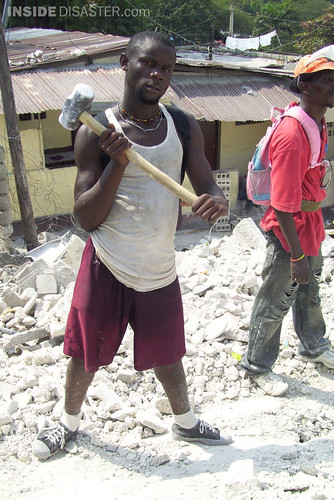I flew into Santo Domingo Saturday on my way back to Haiti and was picked up by one of our Dominican staff members. It being the weekend I asked him if there was any build work going on at any of the job sites. He told me that there wasn't and I quickly remembered the distinction in how our organization works in the US versus in other places around the world. Saturdays are our most active days for building back home in the States since that is when most of our volunteers are able to build. In developing countries (well, really in most countries in general) people are trained and employed to build our houses with a varying component of local and international volunteers coming in to chip in on an individual or group basis.
Volunteering is a great way to directly engage people in solving issues around the world, whether its digging wells in Africa, working in a field hospital in Myanmar, or cleaning up trash at a park in your own town. The concept seems to have its foundation based in Western/developed nation culture but other areas of the world identify with this concept of giving back to those who may need it most or working for the benefit of the greater good.I met a couple of guys a few weeks back who volunteered with an NGO in Gonaives and are now working with the same organization in Leogane now on a stipend based on the good work they did in 2008.
When disasters occur many people take this volunteering spirit to a whole new level. It reminds me of some commericals that used to come on TV for Pike Nurseries with this jingle focused on "playing in the dirt." Some people found it annoying as all heck but I think it was done well for the people they were trying to target. There's a big difference in hiring someone to plant a garden for you versus you doing the planting yourself and getting to feel rich dark earth between your fingertips. I think the same thing is true when it comes to helping communities after a disaster. Even if you can't literally be on the ground it does feel better to be working in a kitchen feeding volunteers or managing a warehouse rather than sitting at home and calling a nonprofit to donate $25 or $50 (maybe not 100% of the time, but you get my drift.)
That means there's a lot of frustration out there when organizations try to hold back the tide on volunteers rushing into to help after a disaster in Latin America, Asia, or Africa. In the case of Africa that tide may not be as high (unfortunately) but its true there as well. Whether its for security reasons, lack of infrastructure, or neutralizing the affected community's ability to tap into its own capacity to recover and rebuild we can say we need help meeting the needs of people but just bringing in more people may not be the right answer at the moment. It gets even more complicated when your organization has a history of bringing volunteers to a place and you suddenly have to restrict that to take new factors into consideration. From the volunteer's standpoint though these things sometimes aren't that clear (and can get even less clear depending on the media coverage.)
So where am I going with this? We have to find ways to help people "get their hands dirty" in other ways when it comes to certain disasters recovery efforts. This could be done by assembling teams to assemble distribution kits or taking in displaced families from the affected area on an interim basis. The NGO community needs to continue to work on these kinds of ideas because we have a bevy of ways (TV, websites, blogs, Facebook, Twitter, YouTube, etc.) to let potential volunteers know what they can do to help in their own community. The volunteers need to consider this guidance well to avoid making mistakes that many NGOs have learned from decades of experience rather than go on their own.
Photo above courtesy of Inside Disaster CC BY-NC 2.0




No comments:
Post a Comment